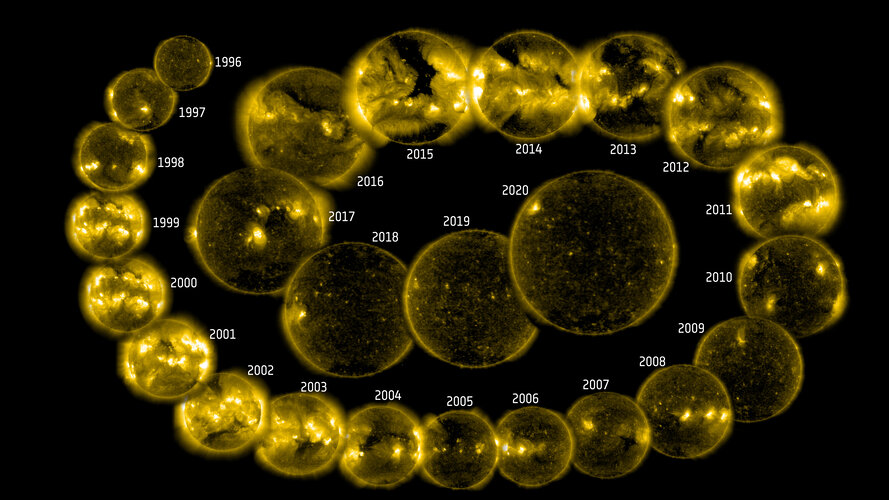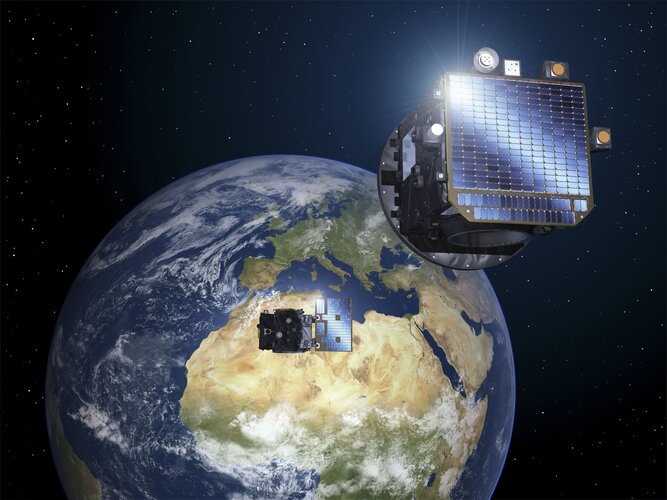
Copernical Team
Earth from Space: Autumn foliage across Europe

This compilation of images, captured by the Copernicus Sentinel-2 mission, showcases the characteristic hues of autumn in different European countries.
The solar cycle, a heartbeat of stellar energy

The Sun follows a roughly 11-year rhythm of waking up and becoming very active before calming down again, a stellar beat known as the solar cycle. This affects Earth because it shapes space weather, determining how much radiation, magnetic field and particles the Sun flings out into space and towards our planet.
Hera burns towards Mars

ESA’s Hera mission has completed the first critical manoeuvre on its journey to the Didymos binary asteroid system since launch on 7 October.
A space walking robot could build a giant telescope in space
This request seems a bit unusual, so we need to confirm that you're human. Please press and hold the button until it turns completely green. Thank you for your cooperation!
Press and hold the button
If you believe this is an error, please contact our support team.
185.132.36.159 : 4da40fb9-c5c6-4b18-955d-ec00e1f1
Image: Astronaut captures photo of Earth from the International Space Station
This request seems a bit unusual, so we need to confirm that you're human. Please press and hold the button until it turns completely green. Thank you for your cooperation!
Press and hold the button
If you believe this is an error, please contact our support team.
185.132.36.159 : bf39b274-2c0f-4a43-bdaa-b4575a9f
Proba-3 will constantly measure Sun’s energy output

Proba-3 is such an ambitious mission that it needs more than one single spacecraft to succeed. In order for Proba-3’s Coronagraph spacecraft observe the Sun’s faint surrounding atmosphere, its disk-bearing Occulter spacecraft must block out the fiery solar disk. This means Proba-3’s Occulter ends up facing the Sun continuously, making it a valuable platform for science in its own right.
Meet ESA’s SME Office at Space Tech Expo 2024

Space startups and SMEs can meet ESA’s SME Office at Space Tech Expo, a space technology trade fair and conference in Bremen, Germany from 19–21 November.
Snow returns to Mount Fuji
 Image:
Snow returns to Mount Fuji
Image:
Snow returns to Mount Fuji Satellite imagery offers a way to shield coastal forests from climate impacts
 Rising sea levels driven by climate change threaten coastal forests with unpredictable consequences, highlighting the need for advanced tools to manage these vulnerable ecosystems and allocate conservation efforts effectively.
In a recent study by North Carolina State University and the U.S. Geological Survey (USGS), researchers explored how satellite imagery could help conservationists id
Rising sea levels driven by climate change threaten coastal forests with unpredictable consequences, highlighting the need for advanced tools to manage these vulnerable ecosystems and allocate conservation efforts effectively.
In a recent study by North Carolina State University and the U.S. Geological Survey (USGS), researchers explored how satellite imagery could help conservationists id 30 Years On, NASA's Wind Is a Windfall for Studying our Neighborhood in Space
 Picture it: 1994. The first World Wide Web conference took place in Geneva, the first Chunnel train traveled under the English Channel, and just three years after the end of the Cold War, the first Russian instrument on a U.S. spacecraft launched into deep space from Cape Canaveral. The mission to study the solar wind, aptly named Wind, held promise for heliophysicists and astrophysicists around
Picture it: 1994. The first World Wide Web conference took place in Geneva, the first Chunnel train traveled under the English Channel, and just three years after the end of the Cold War, the first Russian instrument on a U.S. spacecraft launched into deep space from Cape Canaveral. The mission to study the solar wind, aptly named Wind, held promise for heliophysicists and astrophysicists around 
